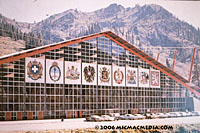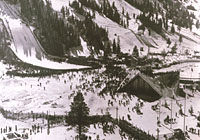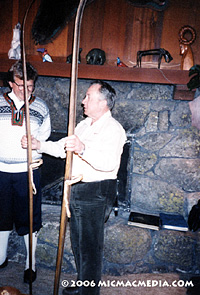 |
|
|
Follow Mark on Facebook for more stories |
||
|
Squaw Valley USA — A Proud Olympic Legacy The 2006 Olympics being held in Torino, Italy, inspires memories of when Squaw Valley hosted the 1960 Winter Olympic Games. The television exposure brought international recognition to the Tahoe-Truckee region and spurred big mountain ski resort development. Getting the Olympics to Lake Tahoe had taken a minor miracle by Alex C. Cushing, co-founder with Wayne Poulsen of the Squaw Valley Development Corporation.
Over his lifetime Poulsen had purchased most of the land on the valley floor (U.S. Forest Service controlled the mountains themselves) , but a major resort couldn't be built without some of it. Cushing's company bought 600 acres from Poulsen and promptly constructed a lift and ski lodge at the base of the KT-22 slope. The KT-22 run earned its moniker after Wayne took his wife Sandy to a steep part of the mountain and expected her to ski down. Well, she had to kick -turn her way back and forth across the slope 22 times until she reached a less steep pitch that she could actually ski. Despite spectacular mountain terrain ideal for challenging skiing, with just one chairlift and two rope tows, Squaw Valley was virtually unknown among skiers. Even in nearby Reno, just 45 miles away, relatively few were aware of the fledgling resort nestled in the remote alpine valley. It was easier to visit Sky Tavern, a modest resort but only a short drive from Reno. Desperate for publicity, in 1954 Alex Cushing submitted a proposal to host the 1960 Winter Games. Cushing believed that even if he failed to bring the Olympics to Squaw, the exposure would inspire financial support for his plan to build a world -class ski resort. To help convince skeptical Olympic delegates that his venue could match up to the great European resorts, he wrote individual letters to each delegate with a vote, and traveled to France with Joe Marillac, a Squaw Valley ski instructor and world-renowned French skier and mountaineer. Marillac was also a hero of the French Resistance in WWII who had rescued downed Allied airmen shot down over German-occupied France.
The International Olympic Committee (IOC) had already decided to award the games to Innsbruck, Austria, but Alex Cushing refused to quit. He brought along a huge model depicting the mountain's impressive topography and Cushing's vision of the as yet unbuilt Olympic village and facility. The scale model was so large that Olympic delegates had to visit the U.S. Embassy lobby to see it. After a heated five-hour session in June 1955, a second IOC ballot gave Squaw Valley a narrow victory of two votes over Innsbruck. An elated Cushing stated, "I am very glad we won. I think moving the Games to the United States will give a tremendous boost to winter sports there. The state of California is very much aware of the great responsibility that has been handed us. We intend to do a first rate job." Site preparation at Squaw Valley took five years of money, work and sweat. No previous Olympic host community had ever attempted even a fraction of what organizers put together at Squaw. The only thing they couldn't control was the weather and initially their worst fears seemed to be coming true. Cushing had told the Europeans that his resort averaged 35 feet of snow, but in late December 1959 there was no snow at the bottom of Squaw Valley. It seemed that the Sierra Storm King was planning to boycott the event. The eyes of the nation and the world were on Squaw Valley's weather. In January 1960 prayers were answered when a barrage of cold storms blanketed the upper slopes at Squaw with more than ten feet of snow. Olympic organizers and local residents were both relieved and jubilant.
Cold air finally lowered the snow level and nearly overnight the snowpack grew to 10 feet deep. Naval units salvaged the damaged parking area by repacking the snow while Army and Marine troops were assigned to stabilize ski runs. Their hard work paid off when a leading official with the International Ski Federation proclaimed the race courses better prepared than those at Oslo in 1952 or at Cortina in 1956. On opening day, the Storm King had one last trick to play. The Weather Bureau was forecasting a slight chance of flurries. Instead, a mini-blizzard that morning cut visibility to zero and dumped eight inches of fresh snow on the thousands of spectators and participants arriving for the scheduled 1:30 p.m. ceremony. Traffic was backed up for miles. The snowfall and monumental traffic jam forced Olympic officials to delay the opening ceremony briefly. The timing was perfect. Just ten minutes later, the snowstorm quit, the wind let up, and sunshine poured down. The change was so dramatic that the Russian delegates wondered if the Americans had invented a machine to control the weather. |
||||||||||||||||||
|



